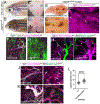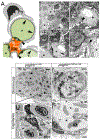Conserved and context-dependent roles for pdgfrb signaling during zebrafish vascular mural cell development
- PMID: 34310924
- PMCID: PMC8410673
- DOI: 10.1016/j.ydbio.2021.06.010
Conserved and context-dependent roles for pdgfrb signaling during zebrafish vascular mural cell development
Abstract
Platelet derived growth factor beta and its receptor, Pdgfrb, play essential roles in the development of vascular mural cells, including pericytes and vascular smooth muscle cells. To determine if this role was conserved in zebrafish, we analyzed pdgfb and pdgfrb mutant lines. Similar to mouse, pdgfb and pdgfrb mutant zebrafish lack brain pericytes and exhibit anatomically selective loss of vascular smooth muscle coverage. Despite these defects, pdgfrb mutant zebrafish did not otherwise exhibit circulatory defects at larval stages. However, beginning at juvenile stages, we observed severe cranial hemorrhage and vessel dilation associated with loss of pericytes and vascular smooth muscle cells in pdgfrb mutants. Similar to mouse, pdgfrb mutant zebrafish also displayed structural defects in the glomerulus, but normal development of hepatic stellate cells. We also noted defective mural cell investment on coronary vessels with concomitant defects in their development. Together, our studies support a conserved requirement for Pdgfrb signaling in mural cells. In addition, these zebrafish mutants provide an important model for definitive investigation of mural cells during early embryonic stages without confounding secondary effects from circulatory defects.
Keywords: Mural cells; Pdgfrb; Pericytes; Vascular smooth muscle cells; Zebrafish.
Copyright © 2021 Elsevier Inc. All rights reserved.
Conflict of interest statement
Declaration of competing interest The authors declare no competing or financial interests.
Figures








References
-
- Ando K, Wang W, Peng D, Chiba A, Lagendijk AK, Barske L, Crump JG, Stainier DYR, Lendahl U, Koltowska K, Hogan BM, Fukuhara S, Mochizuki N, Betsholtz C, 2019b. Peri-arterial specification of vascular mural cells from naïve mesenchyme requires Notch signaling. Development 146, dev165589. - PMC - PubMed
Publication types
MeSH terms
Substances
Grants and funding
LinkOut - more resources
Full Text Sources
Molecular Biology Databases
Miscellaneous

